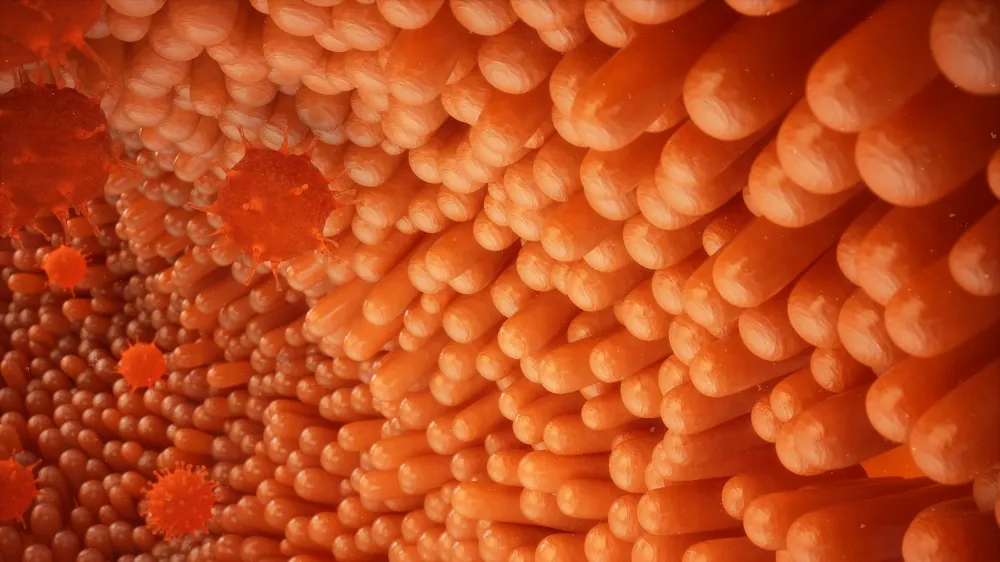Using a pathogen-originated protein and a human antibody, scientists have created a chimeric construct that can deliver protein cargo via the intestine. This technology could potentially replace cumbersome injections [1].
Getting rid of the needle
Protein-based treatments are very powerful, but they cannot yet be administered orally because the human gut breaks proteins down. Instead, such treatments, which include antibodies, certain hormones, and peptides, are administered as injections, which are much more cumbersome to deliver. A new study from the University of Bath, published in the Journal of Controlled Release, offers an ingenious potential solution.
The researchers used the ability of cholix (Chx), a toxin produced by Vibrio cholerae, the bacteria that causes cholera, to penetrate gut cells. They trimmed Chx down to its first 197 amino acids, rendering it benign while preserving its cell-penetrating ability, and linked it to human growth hormone (hGH), which is used to treat certain disorders and is being researched in the context of longevity, with mixed results [2].
To make hGH enter the bloodstream, it must be eventually detached from the Chx domain. The protease (protein-cleaving enzyme) furin can do it, so furin-cleavable sequences were introduced to the chimera. Furin is abundant in enterocytes, the absorptive cells that form the lining of the small-intestinal villi and take up nutrients. The idea was that if the chimera could travel across the entire cell to its basal region, and get cleaved by furin there, hGH would be released into the bloodstream.
Using antibodies did the trick
However, the Chx-hGH chimeras were instead cleaved by furin soon upon arrival in enterocytes, crashing bioavailability. To overcome this challenge, the researchers turned to human IgG1 antibodies, adding one of their domains, CH2, to the chimera.
When grafted onto other proteins, CH2 can sometimes act as an address tag that can direct the chimera towards a certain route inside the cell [3]. The researchers found that CH2-incorporating chimeras less often ended up being cleaved by furin at the apical end of the cell, which faces the intestinal wall. Instead, they seemed to be rerouted and successfully transported across the cell, arriving at the basal end, which faces the bloodstream, and being cleaved by furin there.
The researchers also noticed that these improved chimeras were colocalized with the protein FCRLA. It might be that, with CH2 as a ‘swipe-badge’, the chimera was allowed into FCRLA-marked back corridors, keeping the linker intact for longer. However, the researchers still do not understand the mechanism behind this effect.
With the help of this bag of tricks, the team’s best-performing chimera delivered roughly 4% of the dose into the rats’ bloodstream without any noticeable toxicity. According to the paper, this is among the highest reported in pre-clinical protein studies and more than enough to start thinking about translation into actual treatments.
“This pathway is well understood and has been derived from events in the human intestine, so we know it will work in patients,” said Professor Randy Mrsny, from the University of Bath’s Department of Life Sciences, who led the study. “Unlike previous systems, our method doesn’t damage the epithelium and can generically transport a large range of medications, including hormones and cancer treatments that can currently only be injected. This has the potential to transform the lives of patients who currently have to inject themselves daily, such as children who need to take growth hormones.”
Not exactly the oral route, for now
However, there are a few caveats. First, the delivery in the rat model was performed not orally but by a direct injection into various parts of the intestine while isolating them by clamping the rest of the gut. The researchers found that absorption in the ileum, the final section of the small intestine, was much greater than in the other parts. Compared to this “idealized” method of delivery, the conventional oral route poses significant challenges and would require a lot of tuning.
Second, no antibody-formation or immune-activation studies were performed. The authors do not discuss whether repeated exposure to a bacterial-protein carrier or the human CH2 tag might trigger neutralizing antibodies or hypersensitivity. In summary, the acute rat model that the team used cannot reveal longer-term issues such as receptor saturation in the ileum, effects on gut barrier integrity, or unintended delivery of cargo to immune cells.
The researchers, however, are quite optimistic. “While it’s not the first system to replace injections, ours is the first platform to work safely and consistently, delivering the drug at effective doses and using a well-understood pathway,” said Mrsny. “Once it’s been developed into a pill, our system would be more convenient for patients than injections, meaning no more needles.”
Literature
[1] Taverner, A., Hunter, T., MacKay, J., Varenko, V., Gridley, K., & Mrsny, R. J. (2025). Human Fc CH2 domain modifies cholix transcytosis pathway to facilitate efficient oral therapeutic protein delivery. Journal of Controlled Release, 113964.
[2] Fernández-Garza, L. E., Guillen-Silva, F., Sotelo-Ibarra, M. A., Domínguez-Mendoza, A. E., Barrera-Barrera, S. A., & Barrera-Saldaña, H. A. (2025). Growth hormone and aging: a clinical review. Frontiers in Aging, 6, 1549453.
[3] Ying, T., Wang, Y., Feng, Y., Prabakaran, P., Gong, R., Wang, L., … & Dimitrov, D. S. (2015, September). Engineered antibody domains with significantly increased transcytosis and half-life in macaques mediated by FcRn. In MAbs (Vol. 7, No. 5, pp. 922-930). Taylor & Francis.


